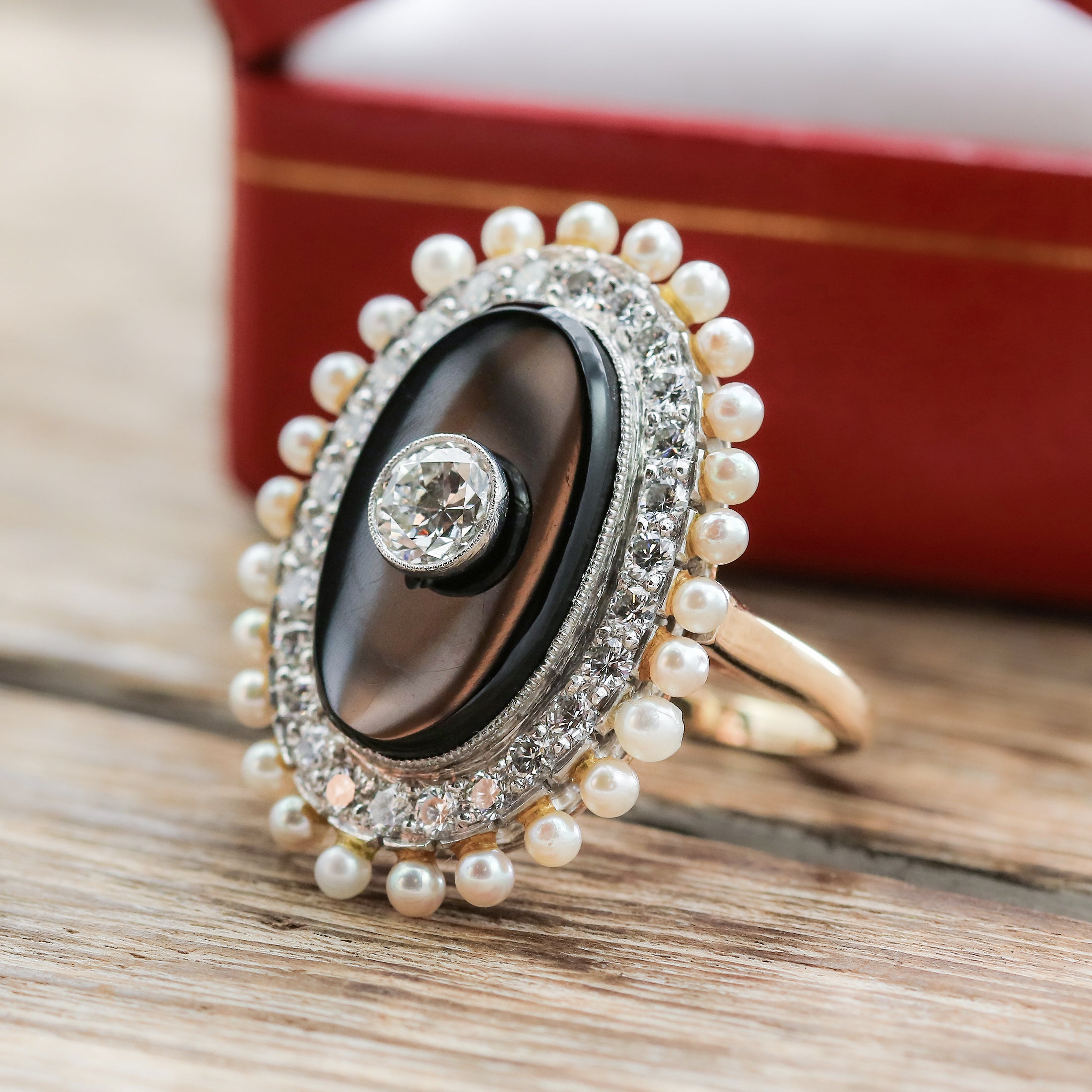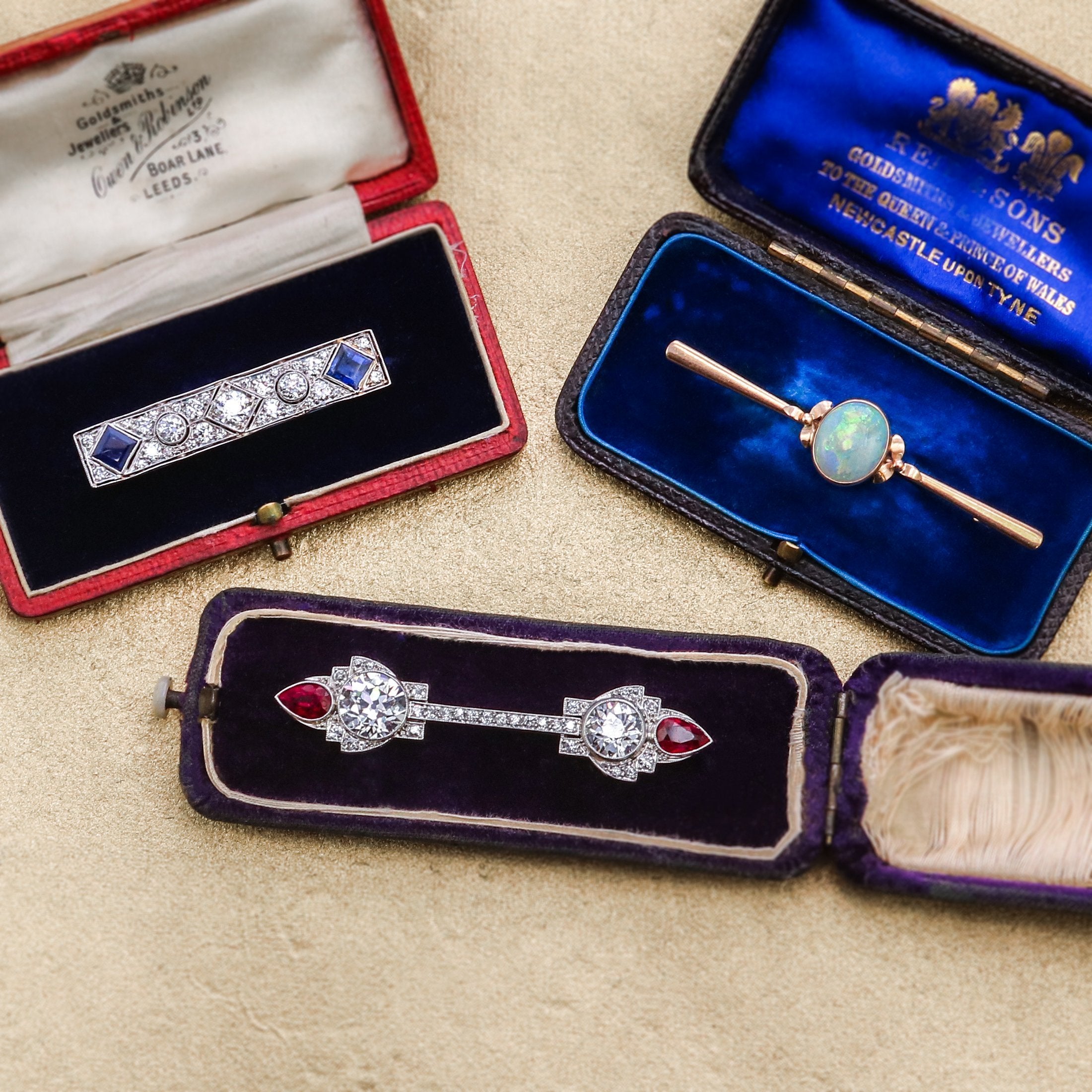
 A late Georgian/Early Victorian sterling silver seed pearl and diamond double bracelet, which can be attached and worn as a necklace.
A late Georgian/Early Victorian sterling silver seed pearl and diamond double bracelet, which can be attached and worn as a necklace.
Towards the end of the Georgian and the beginning of the Victorian period, a time when the middle class was beginning to exist and opulence was revered, one particular accent jewel captivated the hearts of both high society and the fashion-conscious masses: seed pearls. Diamonds were just beginning to become commercially available in large amounts and were not yet ready to become the white stone accent staple we know them as today. Meanwhile, pearls (remember, this is before the age of cultured pearls) were considered the most rare and valuable gemstones in the world. Delicate and undeniably elegant, these tiny pearls became the epitome of Victorian style and grace.
Affordable Luxury
Pearls have symbolized purity, innocence, and wealth for millennia. While larger pearls were very highly sought after, the introduction of seed pearls—tiny, perfectly round pearls—ushered in new opportunities for elegance. Harvested from freshwater mollusks, these minuscule pearls were meticulously sorted by size and skillfully incorporated into stunning creations that adorned women of all ranks. These tiny pearls finally gave the average person the ability to own their first real pearl piece of jewelry, an idea many had probably not believed possible in the past.
Craftsmanship at Its Finest
Creating jewelry with seed pearls was a true testament to the skill and patience of Victorian artisans. Each individual pearl, often no larger than a pinhead, was individually drilled and strung onto fine threads or wires or half drilled and glued onto a tiny post. These fragile strands were often meticulously woven into intricate patterns, resulting in mesmerizing jewelry pieces that showcased the delicate beauty of seed pearls.
Unlike most other gemstones, pearls are also incredibly delicate. Drilling into these tiny, easily broken gems (keep in mind this was before the invention of electric drills or even electricity for lighting) and stringing them ornately on wire is a task I am very grateful is not my responsibility.

Queen Victoria's Influence
No discussion of seed pearl jewelry (or any jewelry trend of the Victorian period) would be complete without acknowledging the profound influence of Queen Victoria herself. After the death of her beloved husband, Prince Albert, in 1861, Queen Victoria entered a prolonged period of mourning. Her public appearances became fewer, and her jewelry became more downplayed and muted. She also began to wear a lot of mourning jewelry, which would often be composed of a piece of onyx accented with seed pearls. Queen Victoria’s public appreciation, combined with the common use of mourning and other sentimental jewelry styles, the popularity of delicate, understated jewelry soared, with seed pearls becoming a public favorite.
Sentimental Symbolism
As with most jewelry trends in the Georgian and Victorian periods, the symbolism behind the jewelry was as important as the fashion. Pearls had long been known to symbolize luxury, grace and purity. They were frequently used to create intricate motifs such as hearts, flowers, and crosses, symbolizing love, devotion, and faith. Additionally, seed pearl jewelry was often gifted as tokens of affection or presented as wedding jewelry, symbolizing the eternal bond between partners.
Types of Seed Pearl Jewelry
Seed pearls were not just designated for mourning and wedding jewelry. Seed pearl accents in jewelry came in a wide array of designs, with each piece reflecting the Victorian’s appreciation for delicate detailing. Necklaces, bracelets, brooches, earrings, and tiaras adorned with seed pearls were all the rage. Most often set in gold or silver and used to accent ornate designs or other gemstones, these jewels exuded a subtle opulence that perfectly complemented the refined tastes of the era.
Seed Pearls Lose Their Luster
While seed pearl jewelry reached the pinnacle of its popularity during the Victorian era, their use in jewelry continued for decades. The widespread availability of diamonds slowly reduced the demand for seed pearls over time, probably because they were far easier for jewelers to work with and served a similar purpose in regards to offering a small, white accent stone. The durability of diamonds also meant that people would be able to wear them freely without worrying as much about their favorite piece breaking. Even as popularity slowly dwindled, seed pearl jewelry can be commonly found throughout the Edwardian and Art Deco periods.

How to Care for Seed Pearls
To ensure the longevity and beauty of seed pearl jewelry, proper care is essential. Due to their delicate nature, these tiny pearls require gentle handling and protection from harsh chemicals, moisture, and excessive heat. It's advisable to store them separately in a soft pouch or jewelry box, away from other pieces that may scratch or damage them. Occasional cleaning with a soft cloth is all they need to maintain their luster and shine, ensuring that these precious treasures can be enjoyed for years to come.
If you are cleaning a stone in a piece of jewelry with seed pearl accents, it is best to avoid using the jewelry cleaning solutions you may normally use for diamonds, rubies or sapphires. The best solution would be mild mixture of Dawn dish soap and warm water being scrubbed softly with a tooth brush before being rinsed off with water. Drying them with a hair dryer would not be recommended.
From Victorian Times to Today
From Queen Victoria's personal preference to the sentimental symbolism it carried, seed pearl jewelry captured the hearts of Victorian society and continues to fascinate vintage jewelry enthusiasts today. As we admire these tiny treasures, we are reminded of the artistry and legacy of a bygone era. However, the allure of seed pearl jewelry doesn't end with mere admiration, these pieces are still suitable to being worn today. The internet opening up the past to fashion influencers has led to everyone having the ability to craft their own unique style. The elegance that defined the Victorian era has certainly found a place in modern fashion.
More Pictures of Antique Seed Pearl Focused Jewelry
 Victorian 15k yellow gold turquoise and seed pearl dangle earrings
Victorian 15k yellow gold turquoise and seed pearl dangle earrings
 An Art Nouveau depiction of a woman in yellow gold with a colorful enamel backing and seed pearl accents
An Art Nouveau depiction of a woman in yellow gold with a colorful enamel backing and seed pearl accents
 Victorian mourning necklace featuring onyx, black enamel and a seed pearl accent reading "In Memory of" on the front
Victorian mourning necklace featuring onyx, black enamel and a seed pearl accent reading "In Memory of" on the front
 An elaborate Victorian peridot and seed pearl necklace set in yellow gold
An elaborate Victorian peridot and seed pearl necklace set in yellow gold
 Art Nouveau enamel, peridot and seed pearl necklace created by renowned design house Krementz & Co
Art Nouveau enamel, peridot and seed pearl necklace created by renowned design house Krementz & Co
 Art Deco amethyst ring set in an elaborate filigree ring made of white and yellow gold with seed pearl accents
Art Deco amethyst ring set in an elaborate filigree ring made of white and yellow gold with seed pearl accents
- Read More
- Joseph Denaburg
- /
- 0 Comment(s)



